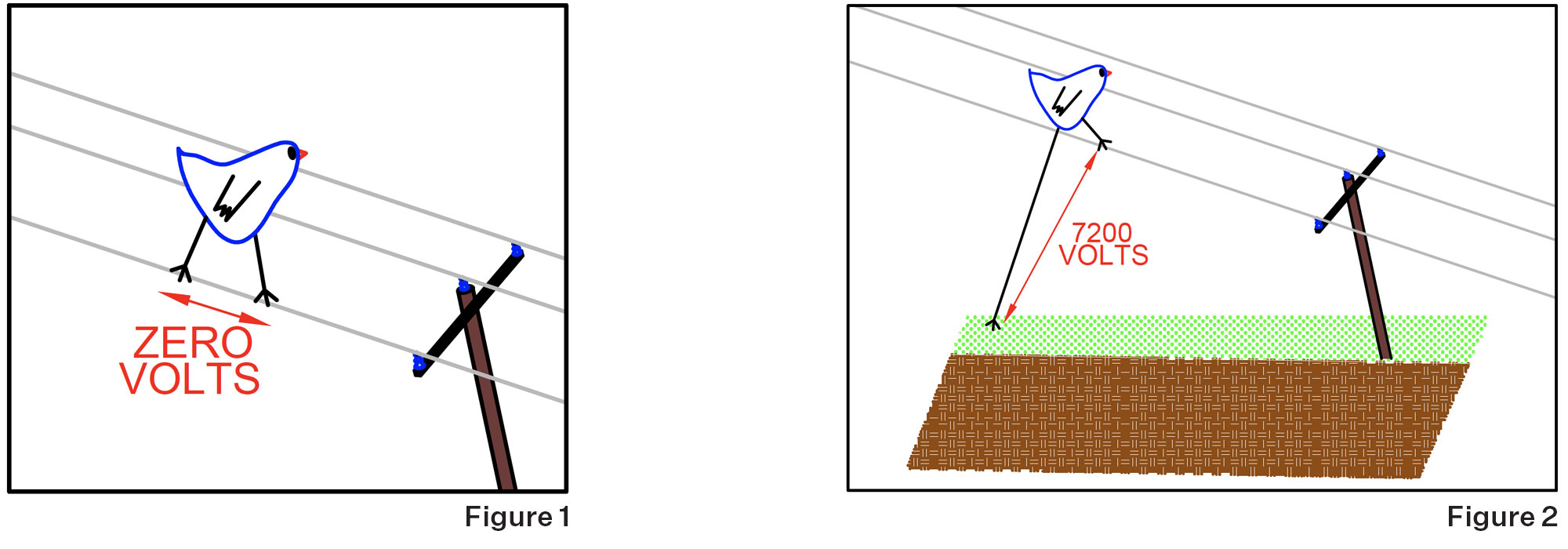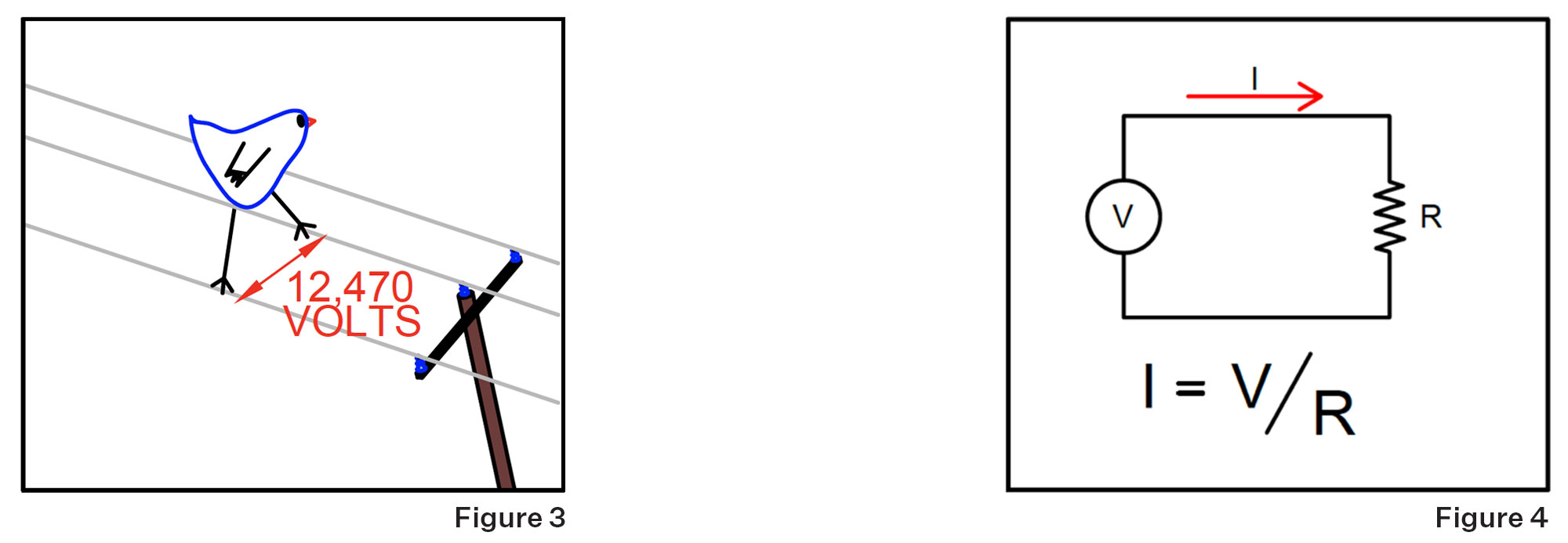Birds Do It. Not Sure if Bees Do It. But How Do They Do It? Could You Do It?
We have all seen birds roosting on powerlines. Do you ever wonder why they’re not electrocuted? As shown in the picture above, birds come to rest on powerlines all the time and yet we don’t see the ground littered with electrocuted birds. By the way, the word electrocuted is a portmanteau from electricity and executed (portmanteau is a fancy term for blending two words to form a new word). Electrocution originally meant to be put to death in the electric chair. That is why in technical papers engineers typically avoid the term electrocution and typically use a term like shock event or electrical contact accident.
But back to the question, why are birds not shocked when they land on utility powerlines which may be energized at 12,000 volts or more? It’s because a bird on a single powerline has both feet at the same voltage as shown in Figure 1. For a shock event to occur a bird - or person - for that matter would have to have body parts in contact with surfaces at different voltages. For example, if an unfortunate bird with an extremely long leg had one foot on a utility line and the other foot on the ground as shown in the figure below, they would be killed.
In the case shown in Figure 2, one foot is at 7200 volts with respect to the ground. The other foot is grounded so the bird sees a voltage of 7200 volts. Of course, birds can’t keep one foot on the ground when perched on a power line. But birds are not entirely safe from electric shock on power lines. For example, large birds like eagles with a wide wingspan can sometimes bridge the distance between two separate energized lines as illustrated in the figure below.

In Figure 3 the bird will see a greater voltage between its feet than the bird with one foot on the ground. The voltage between lines is 173 % (√3) greater that the voltage between a line and ground. In either case the difference in voltage will cause a current to flow in one foot, through the bird’s body, and out the other foot. It is the current that will get you. The determining factor in the type and degree of injury in an electrical contact accident is the magnitude of current flow not just the voltage.

The magnitude of current flow is a function of the voltage and the resistance as shown in Figure 4. The current (I) in a circuit is equal to the voltage (V) divided by the resistance (R). In the case of human contact - say in the case where a person has one hand on an energized wire, - like an exposed wire on a power cord - and the other hand on a grounded surface - like a water faucet - the resistance is the combination of contact resistance of each hand and the internal body resistance as illustrated in the Figure 5.

Electric shock occurs when an individual is exposed to a voltage that produces current flow in the body. The human body’s internal resistance (labeled RBODY) is typically about 300 ohms (W)¹. The contact resistance of the hands (labeled RHAND) can range from hundreds of thousands of ohms to nearly zero ohms (in the case of an exposed wound). Calloused dry hands may have a resistance of 100,00 W each. The current flow (I) is equal to the applied voltage (V) divided by the sum of the resistance (RBODY + RHAND + RHAND ) as shown in the figure below.
In the example shown in Figure 6 and Figure 7, the current through the body would be about 0.006 amperes (A) or about 0.6 milliamps (mA). The effect of various current flows in the human body is shown in the table below.

In Figure 8 0.6 mA, which is 6/10,000 of an ampere, would be just below the level of perception. If one’s hands were wet, the resistance in each hand may drop to 350 W. The current flow would be 120 mA, as shown in the figure to the right, which would be expected to cause the heart to go into ventricular fibrillation

As with most things in physics, biology, and engineering the real world is more subtle and complex than the simple equations provided in this blog. For example, exposure to voltages above 500 volts will cause tissue breakdown - in which case it will matter little how dry and calloused your hands are. Also, the duration of exposure effects the outcome. A 100 mA exposure that last for 0.05 seconds will be barely perceptible, whereas a 100 mA exposure that last for 5 seconds has a greater than 50 % chance to cause ventricular fibrillation.
As noted in the table above a current flow of just 2 A can cause burns and internal tissue damage; given that the smallest typical household breaker is rated 15 A, you realize that most protective devices offer little to no protection in the case of a shock event (one exception is ground fault interrupter circuit (GFIC) breakers and receptacles)
One take away of this discussion is there is no safe way to contact energized electrical equipment…
…unless you are a bird.
About the Author
Gary W. Mullis, M.Eng., P.E. is a Consulting Engineer in our Charlotte, North Carolina Office. Mr. Mullis provides consulting in the areas of design and performance of electrical power distribution, transmission, and generation, including fire origin and cause analysis, scope of damage, and repair/replacement economic and technical feasibility analysis. His areas of expertise also include electrical system and equipment performance during fault and unbalanced conditions, as well as analysis of electrical contact accidents, arc flash events, and direct stoke lightning. You may contact him for your forensic engineering needs at gmullis@edtengineers.com or (704) 523-2520.
Learn about how EDT Forensic Engineering & Consulting approaches damage assessment to commercial and industrial and forensic engineering by assigning a file today.
¹ Fish, R. M., & Geddes, L. A. (2009). Conduction of Electrical Current to and Through the Human Body: A Review. Eplasty, 9,
² Worker Deaths by Electrocution; A Summary of NIOSH Surveillance and Investigative Findings, U.S. Department of Health and Human Services, Public Health Service, Centers for Disease Control and Prevention, National Institute for Occupational Safety and Health, May 1998.

